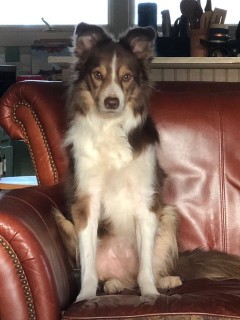How to Talk to Your Dog: Becoming Cue Savvy
Zen sits on the sofa across the room and stares at me. What does he want?
If I ask him "what do you want?" he cannot answer me in words. But he can still tell me. How? By what he does.
If he jumps up, grabs a toy, and deposits it in my lap he has just clearly communicated his current desire to me. Let's say I'm busy and don't want to play right at that moment. So I tell him "go lay down" and he heaves a sigh of disappointment, but goes back to the sofa and settles into a relaxed down to nap for a while longer.
I used my "go lay down" cue and he completely understood what it meant. He didn't like it, but he understood it. We had clear mutual communication.
Talking To Your Dog: Establishing a Mutual Communication System
The foundation of all excellent dog training is a well-understood mutual communication system. If you can communicate clearly and consistently with your dog, and you listen when your dog communicates in response, things will be so much easier and more fun for both of you. When two creatures already speak very different languages establishing a shared one is incredibly important.
As humans we tend to be a very verbal species. We talk. We talk a LOT. Much of what we say is fluff and excess. LIke Charlie Brown's teacher we are mostly unintelligible white noise. We use many words that are not really necessary for understanding; especially with animals who are not verbal as well.
Dog communication relies much more on visual stimuli and movement than it does on spoken language. Dogs look, see things, and move around accordingly. We need to watch them closely to begin learning their preferred language. We need to interpret their actions so that we can better understand what they want and need. That's our job as trainers and owners. It's not an easy one because we often misinterpret what we see. We do this precisely because we do not have a shared language.
How Cue Savvy Are You?
When trainers think about establishing cues for behaviors they often think of that as a one-sided process. I think this goes back to the idea of giving dogs commands. Commands do not encourage mutual communication; only obedience. That's a very different form of interaction than using cues and then observing the dog's response to them.
People think that once they begin using a cue then the dog, in some magical fashion, learns to connect the cue to the desired behavior. This process is a bit fuzzy and vague to many trainers, and it shows in the results. The truth of the matter is that we are often quite casual and haphazard in how we teach cues, and often our dogs figure it out in spite of us, not because of us.
If we don't understand how cues work we are not cue savvy. And if we are not cue savvy how in the world can we expect our dogs to be?
Applying cues to behaviors, strengthening our dogs' understanding of those cues, and changing to new cues is all clear science. There are ways to do this that make learning and understanding much much easier for our dogs. And then there are ways that are unclear and sloppy and impede progress rather than enhancing it. If you understand the science you are making your job of teaching, and your dog's job of learning, so much easier. Understanding how to work with cues falls under the "simple but not easy" umbrella. The principles of how it works are actually pretty straightforward, but the application is where things can get tricky.
Click here to check out the workshop and get registered now!
By accepting you will be accessing a service provided by a third-party external to https://www.fenzidogsportsacademy.com/
